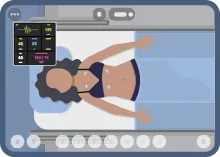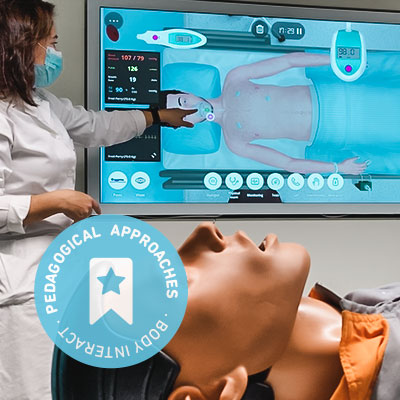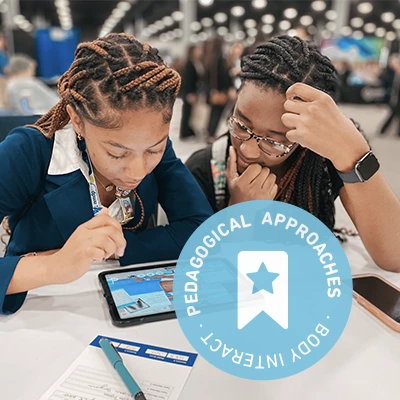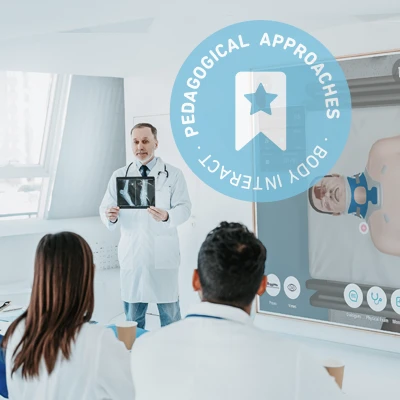Pedagogical Approaches with Body Interact | Large Group Teaching
What is Large Group Teaching?
Large group teaching refers to instructional methods used to teach a significant number of students simultaneously, typically in an auditorium or even in a virtual setting.
It is a common instructional method in clinical education, especially during the pre-clinical years, when foundational knowledge in subjects such as anatomy, physiology, pharmacology, and pathology is delivered to large cohorts of students. However, it presents several challenges.

Key aspects of Large Group Teaching include:
Audience Size: The group typically consists of a large group of students (dozens to hundreds).
Format: The most common format in which large classes are conducted is a lecture, but modern large group teaching may also include interactive elements.
Content Delivery: This kind of teaching commonly focuses on delivering foundational and standardized knowledge.
Technology Integration: Often professors integrate tools like slides, videos, audience response systems, live polling, and digital tools, such as Body Interact Virtual Patients (VP) to enhance engagement.
The evidence suggests that questioning whether large group teaching is or is not a good thing is fruitless. It is more profitable to consider how lectures work, for whom, in what ways, with what outcomes, and how the activity, method, and system of lecturing can be improved.
Tworek, 2013
This quote challenges us to accept that large group teaching in healthcare-based curricula is a reality, even if it is sometimes not the most effective learning approach.
Challenges of Large Group Teaching:
Passive Learning: Traditional lectures often promote passive learning, where students receive information without active engagement, leading to lower levels of knowledge retention.
Limited Interaction: The large class size limits opportunities for meaningful interactions between students and professors, hindering feedback and more personalized learning experiences.
Diversity of Learning Paces: Students have varying backgrounds and learning speeds, making it challenging to address individual needs in a large group setting.
Reduced Motivation and Engagement: The lack of interactions and active learning strategies can decrease student motivation and participation, leading to surface-level learning rather than deep understanding.
How can Virtual Patients be integrated with Large Group Teaching?
Addressing these mentioned limitations requires integrating active learning strategies and fostering interactive environments to enhance the effectiveness of large group teaching in medical education, and Body Interact can be one of the solutions!

1. Case-Based Discussions
How: Present a Virtual Patient case to the entire group using projection or screen sharing. Guide students through the case step-by-step. (Eg: A cardiology lecture uses a VP to simulate a patient with chest pain, allowing the group to discuss differential diagnoses and investigations.)
Benefits: Engages students in decision-making and clinical reasoning in real-time while the instructor facilitates discussion.
2. Interactive Polling
How: Integrate Body Interact Virtual Patients with audience response systems (eg. Poll Everywhere, Mentimeter). Students can choose the clinical decisions and interventions to be conducted (eg. ordering tests, prescribing medication, diagnosing) based on the Virtual Patients scenario. (Eg: Present a VP with a certain symptom, and poll the group to decide the next step.)
Benefits: Encourages participation and allows the professor to measure collective understanding.
3. Flipped Classroom [+]
How: Assign a Virtual Patient scenario for independent study before the lecture. Use the large group session to analyze student responses, clarify misconceptions, and discuss alternative management approaches. Or, assign a different Virtual Patient scenario as an extended resource for students to solve after class. (Eg: Students review a VP with asthma exacerbation by themselves, then discuss treatment priorities and outcomes in class.)
Benefits: Shifts passive learning to active problem-solving and reflection during the session.
4. Group Problem-Solving
How: Divide the large group into smaller teams (in-person or via breakout rooms online). Each team works on the same Virtual Patient scenario and reports their conclusions to the entire class. (Eg: Teams diagnose and manage a VP with acute appendicitis, then compare their approaches with others.)
Benefits: Encourages teamwork, peer learning, and collaborative decision-making.
5. Acute Care Decision-Making Exploration
How: Use a Virtual Patient to walk students through a full clinical encounter during the lecture. Pause at key decision points to brainstorm ask students for input (maybe using an interactive polling system) and/or explain the rationale behind different clinical pathways. (Eg.: A VP with a suspected Ischemic Stroke and BP>185 mmHg guides a session on the importance of time-sensitive interventions like administering or not fibrinolytic medication).
Benefits: Demonstrates clinical workflow while allowing students to be part of the process.
6. Debriefing and Reflection
How: After completing a Virtual Patient scenario as a group, debrief by discussing the outcomes, decisions, and alternative approaches. Prepare key questions and issues to be discussed by students, and highlight lessons learned. (Eg.: Reflect on a case where a VP deteriorates due to delayed recognition of sepsis, emphasizing early warning signs.)
Benefits: Reinforces critical thinking and reflective practice.
7. Virtual Patient Pathway
How: Prepare a structure of a decision tree with blanks to be fulfilled related to the Virtual Patient scenario to challenge students’ reasoning, by breaking down complex clinical scenarios into manageable steps. Promote formative assessment during the lecture, and provide feedback on decisions and inputs made by the group. (Eg.: Explore the different paths of a case where a VP complains of chest pain describing it as a ´pressure-like’ sensation, to explore differential diagnosis, treatment plans, or/and management pathways.)
Benefits: Enhances students’ systematic thinking and problem-solving skills and exposes them to diverse clinical pathways. Allows students to test their knowledge in a low-stakes environment and understand their strengths and weaknesses.
8. Handoff Exercise
How: Use a Virtual Patient to conduct a handoff exercise. (Eg.: Distribute or create an online template of a handoff to your students and go through the VP scenario serving as the clinical patient they have to report on.)
Benefits: Ensures future healthcare workers can provide accurate, critical, and effective information on the patients. Preparing handoffs allows students to develop critical thinking, prioritizing, and the ability to synthesize and summarize complex information.
9. Clinical Error [+]
How: Make the most out of the Body Interact physiologic algorithm and use a Virtual Patient scenario to demonstrate the impact of clinical errors. Create the error in real-time or record yourself performing it, then discuss the reason behind the error and how students should address clinical mistakes. Conclude by managing the patient according to the appropriate guidelines and protocols. (Eg.: Administer medication to a patient despite the patient or briefing indicating an allergy and explore the case from this induced situation.)
Benefits: Helps students to create awareness and adopt safety protocols, identify cognitive bias, and foster the ability to adapt and apply lessons from errors to prevent their repetition.
What are the benefits of integrating Body Interact Virtual Patients in Large Group Teaching?
Combining large group teaching with Body Interact Virtual Patients can significantly enhance the teaching and learning experience of future healthcare workers. This approach merges the efficiency of delivering content to a large audience with the interactive and problem-solving nature of Virtual Patient.
- Active Learning: Promotes active learning in a large group setting.
- Skills Development: Develops diagnostic and decision-making skills, offering insight into the consequences of clinical actions in a risk-free setting.
- Scalability and Inclusivity: Ensures that every student, regardless of group size, has equal opportunities to engage with the content.
- Immediate Feedback: Helps students understand the impact of their decisions and reinforces learning in real-time.
- Contextual Learning: With its realistic scenarios, it bridges the gap between theoretical knowledge and clinical application
- Enhanced Engagement: Reduces the monotony of traditional lectures and promotes interest through active participation.
- Adaptable to Multiple Teaching Objectives: Body Interact scenarios can be used for different objectives, such as diagnosing diseases, exploring treatment pathways, managing acute care, or making a thorough physical assessment.
- Flexibility for Hybrid or Online Learning: Integrate Virtual Patients into in-person, hybrid, or fully online large group teaching.
Large Group Teaching best practices suggestions:
- 1. Define clear learning objectives: Provide students with a roadmap of what they will learn and achieve.
- 2. Prior knowledge activation: According to the Constructivist Theory, students can better understand complex concepts by relating them to previous knowledge.
- 3. Organize contents in chunks: This avoids cognitive overload and improves retention.
- 4. Incorporate interactive elements: Use Virtual Patients, polls, and brainstorming to keep students engaged.
- 5. Use visual aids: Make content visual through diagrams, videos, and concept maps.
- 6. Use technology to enhance learning: Integrate resources such as Body Interact to engage students and provide real-time feedback.
- 7. Summarize and reinforce key points: ensure consolidation of core concepts by outlining the summary of main ideas and take-home messages.
- 8. Provide formative assessments and opportunities for reflection: Integrate low-stakes quizzes, and case-based and reflective questions to reinforce and identify learning gaps.
Large group teaching is a cornerstone of clinical education, so why not make it more interactive with learning activities like Body Interact Virtual Patients that actively engage students?
Who is using this instructional strategy?
Professors from Universidad Nacional Autónoma de México are using Body Interact Virtual Patients with large cohorts of students.

Want to know more about this pedagogical approach? Would you like to share your pedagogical approach with us?
References
1. Cantillon P. Teaching large groups BMJ 2003; 326 :437 doi:10.1136/bmj.326.7386.437
2. Luscombe C., Montgomery J. Exploring medical student learning in the large group teaching environment: examining current practice to inform curricular development. BMC Med Educ 16, 184 (2016). https://doi.org/10.1186/s12909-016-0698-x
3. Moffett J, Berezowski J, Spencer D, Lanning S. An investigation into the factors that encourage learner participation in a large group medical classroom. Adv Med Educ Pract. 2014;5:65–71.
4. Si J. Using cognitive load theory to tailor clinical reasoning training for preclinical medical students. BMC Med Educ 24, 1185 (2024). https://doi.org/10.1186/s12909-024-06111-9.
5. Tworek J, Ellaway R, and Dornan T, ‘Large group teaching’, in Kieran Walsh (ed.), Oxford Textbook of Medical Education, Oxford Textbook (Oxford, 2013; online edn, Oxford Academic, 1 Oct. 2013), https://doi.org/10.1093/med/9780199652679.003.0014
6. Verma A, Patyal A, Meena JK, Mathur M, Mathur N. Interactive teaching in medical education: Experiences and barriers. Adesh Univ J Med Sci Res 3, 69-73 (2021).









